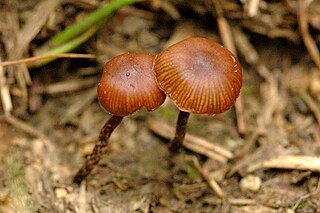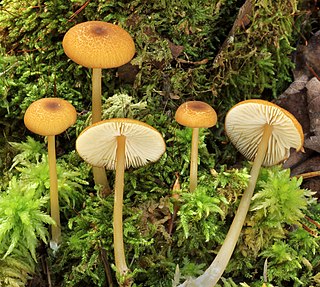Related Research Articles

Entoloma sinuatum is a poisonous mushroom found across Europe and North America. Some guidebooks refer to it by its older scientific names of Entoloma lividum or Rhodophyllus sinuatus. The largest mushroom of the genus of pink-spored fungi known as Entoloma, it is also the type species. Appearing in late summer and autumn, fruit bodies are found in deciduous woodlands on clay or chalky soils, or nearby parklands, sometimes in the form of fairy rings. Solid in shape, they resemble members of the genus Tricholoma. The ivory to light grey-brown cap is up to 20 cm (7.9 in) across with a margin that is rolled inward. The sinuate gills are pale and often yellowish, becoming pink as the spores develop. The thick whitish stem has no ring.

Entoloma is a genus of fungi in the order Agaricales. Called pinkgills in English, basidiocarps are typically agaricoid, though a minority are gasteroid. All have salmon-pink basidiospores which colour the gills at maturity and are angular (polyhedral) under a microscope. The genus is large, with almost 2000 species worldwide. Most species are saprotrophic, but some are ectomycorrhizal, and a few are parasitic on other fungi. The type, Entoloma sinuatum, is one of several Entoloma species that are poisonous, typically causing mild to severe gastrointestinal illness.

The Entolomataceae are a family of fungi in the order Agaricales. The family contains eight genera and 2250 species, the majority of which are in Entoloma. Basidiocarps are typically agaricoid, but a minority are cyphelloid. secotioid, or gasteroid. All produce pink basidiospores that are variously angular (polyhedral), ridged, or nodulose. Species are mostly saprotrophic, though a few are parasitic on other fungi. The family occurs worldwide.

Willem Meijer was a Dutch botanist and plant collector.

Orson Knapp Miller Jr. was an American mycologist. He published numerous papers in mycology and was responsible for the naming of many taxa, as well as being one of the authors erecting the genus Chroogomphus. He described Omphalotus olivascens, several species of Amanita, and the ghoul fungus Hebeloma aminophilum.
Marinus Anton Donk was a Dutch mycologist. He specialized in the taxonomy and nomenclature of mushrooms. Rolf Singer wrote in his obituary that he was "one of the most outstanding figures of contemporary mycology."

Josef Velenovský was a Czech botanist, mycologist, pteridologist, and bryologist. He also worked with fossils. He was a research investigator and professor in the Botanical Institute of the University of Prague, alternating with his colleague Ladislav Josef Čelakovský. He was also professor of botany at Charles University, where he concentrated in the study of mycology in the final half of his life. Velenovský collected innumerable specimens, particularly in new central Bohemia. He was a prolific author of new fungal species, having formally described about 2700 in his career. Many of his type specimens and other collections are located in the herbarium of the Národní Museum of Prague.

Entoloma bloxamii, commonly known as the midnight blue entoloma, or big blue pinkgill, is a species of agaric in the family Entolomataceae. The species has a European distribution, occurring mainly in agriculturally unimproved grassland. Entoloma bloxamii has been reported from North America, but at least some of these reports represent a distinct species, Entoloma medianox. Threats to its habitat have resulted in the Big Blue Pinkgill being assessed as globally "vulnerable" on the IUCN Red List of Threatened Species.

Deconica is a genus of mushroom-forming fungi in the family Strophariaceae. It was formerly considered synonymous with Psilocybe until molecular studies showed that genus to be polyphyletic, made of two major clades: one containing bluing, hallucinogenic species, the other non-bluing and non-hallucinogenic species. Deconica contains species formerly classified in the sections Deconica and Coprophila of Psilocybe.

Entoloma mathinnae is a species of agaric fungus in the family Entolomataceae. Known only from Tasmania, Australia, it was described as new to science in 2009. Mushrooms have light yellow-brown, convex caps up to 8 cm (3.1 in) wide atop stems measuring 5–8.5 cm (2.0–3.3 in) long.

Entoloma holoconiotum is a mushroom in the family Entolomataceae. It was originally described as Nolanea holoconiota by David Largent and Harry Thiers in 1972. Machiel Noordeloos and Co-David transferred it to the genus Entoloma in 2009. The species can be found in conifer forests in western North America.
Pedro Willem Crous is a South African mycologist and plant pathologist.
Dr Teresa Lebel is a taxonomist and ecologist who works on fungi, with a particular interest in subterranean truffle-like fungi and their mushroom, bolete, bracket or cup relatives.
Josef Herink was a Czech physician and mycologist.

Entoloma prunuloides is a species of agaric in the family Entolomataceae. It has been given the recommended English name of Mealy Pinkgill, based on its distinctive smell. The species has a European distribution, occurring mainly in agriculturally unimproved grassland. Threats to its habitat have resulted in the Mealy Pinkgill being assessed as globally "vulnerable" on the IUCN Red List of Threatened Species.

Entoloma griseocyaneum is a species of agaric in the family Entolomataceae. It has been given the recommended English name of Felted Pinkgill. The species has a European distribution, occurring mainly in agriculturally unimproved grassland. Threats to its habitat have resulted in the Felted Pinkgill being assessed as globally "vulnerable" on the IUCN Red List of Threatened Species.
Genevieve M. Gates is an Australian mycologist, ecologist, and taxonomist who is particularly focused on the fungal diversity of Tasmania.

Entoloma formosum is an inconspicuous yellowish-brown mushroom in the family Entolomataceae which are distinguished by their pink angular spores.
References
- ↑ "Dr. M.E. Noordeloos". University of Leiden, Nationaal Herbarium Nederland. Archived from the original on 6 August 2010. Retrieved 21 December 2010.
- ↑ "Editorial Board". PERSOONIA - Molecular Phylogeny and Evolution of Fungi. National Herbarium Nederland. 2011. Archived from the original on 27 July 2011. Retrieved 4 January 2011.
- ↑ Geml J. (2009). "Dr Machiel Noordeloos receives the Clusius Award". Persoonia. 23: 178. doi:10.3767/003158509X482951. PMC 2802724 . PMID 20198167.

- ↑ International Plant Names Index. Noordel.
- ↑ Hausknecht A. (1999). "Entoloma noordeloosi, eine neue Art der Sektion Rhodopolia aus Österreich". Österreichische Zeitschrift für Pilzkunde (in German). 8: 149–52.
- ↑ de Meijer AAR. (2008). Notable Macrofungi from Brazil’s Paraná Pine Forest. Colombo: Embrapa Florestas.